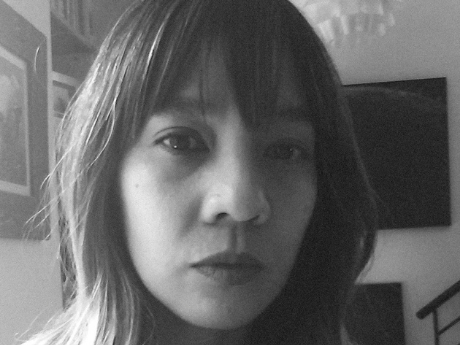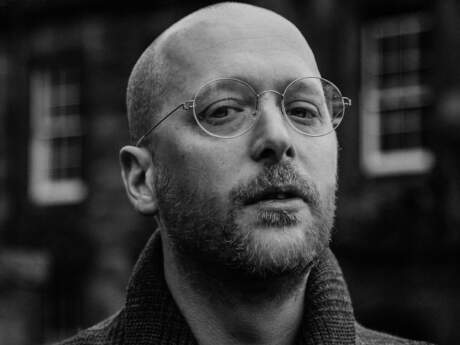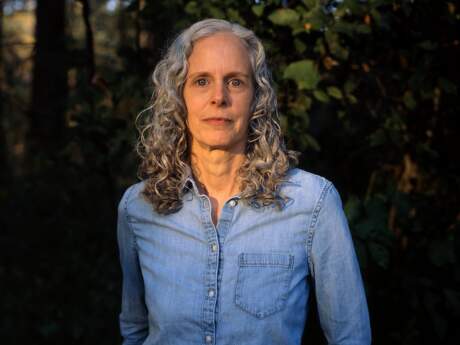In Their Own Words
Dao Strom on “(In) Dead Time”

(IN) DEAD TIME
after Anne Carson
In the small triangular church
on the world’s youngest island I lost
the note usually would anchor.
Music too a form of wind.
Pushing me.
Away from the shore of words.
I had brought with myself
anchors of selves, it’s true.
Some of us always lead with our undertow.
I thought the anchor note a D.
Maybe a slippery A.
At any rate I could not find where to begin.
History has such heavy feathers.
History has so many tiny
F(e)athers.
Tiny deaths.
Cataclysms reign History.
And life is short.
But here where
the invisible are seen—
At first I misheard it as “heathen”.
When Steindór spoke
about them, the “hidden” living
in the seacliffs.
Born to a temporary country
I am one who may also mishear
“nation” as “heathen”.
Standing thus in the long grass
of the heathen valley between boulders
I try to list(en).
Meanwhile body and wind conspire.
To beat me back.
Into basic acoustics.
Of an instrument-self.
But loosed of words.
[What] did I come here [to lose].
Because I am also a little dead inside.
Wonder becomes
a painful salve.
People who live here
don’t have the same
needs of landscape, I think.
Hole inside the studio.
Again inside historical (pre)occupations.
Photographs of bodies, white men
looking on. Unlike Anne, here I am
not reading Proust.
But: Theresa Hak Kyung Cha.
Because lineage is short
for those heathen from nations.
Theresa called it: temps mort.
No-placers; new-placers.
One’s whole living rhetoricized as
Dead time.
How important is the root note?
In the church I sang anyway.
Forgoing words.
Trying to shape voice
into readable arrangements.
Of echoes and feedback.
Singing is just a controlled form of screaming.
And the singing-body source
: a red dot.
Located in the sacrum.
From there voice ascends. I learned this from another
Korean woman artist/emigré.
As voice emigrates higher (in body
and pitch): you see how grows greater
also its distance from the red dot?
Hence you must work harder.
Especially in the head voice.
To keep it connected.
Admittedly: sometimes
I feel married more to distance
than to body of a partner.
I mourn the red dot.
Feeling for it.
Ethos another way of trying to get back.
Into possession of or by.
Heathen as or from.
Who knows.
My husband is a patient man.
He braves the blizzard
to walk to the market.
Once he told me about a guitar player
who wished he could
open his mouth
and have only music
pour out. Instead of words.
What is desire.
In truth I have felt more at home
inside some songs
than in any geography.
Occasionally I dream I’ll die
in another land. Someday uncitizen
-ed. I am still looking for it.
Walking along the sea cliffs
one afternoon I met a rock
I liked very much.
It was black with orange
bits of moss and snow
brightening it.
What would it be like to
hear the rock sing.
Eons of turbulence.
Striated.
Wind-whipped.
A voice from the oldest layer.
I know it’s projecting.
To apply music to inhabitation
of either distance or place.
Dohee says the power of the red dot
will come from your ancestors.
“Open the gate.”
I think of Theresa
who was raped and strangled.
And Dohee who chants
& drums & dances, now—
three decades later. Meanwhile
I spy my ancestors savoring
a sour fruit. While I wrestle
to conjure a concept of pitch
that may convey them.
Their atonal unisons.
Their a-national harmonies.
Their a-coexistence. I dream.
Of perfect octaves.
A drum in the lung. Heartbeat.
In the finger.
The hidden in each of us.
Heathen and heard.
Light sings, too.
In the studio my microphones
are wild with a wind of their own in-
constant mind.
So I give up on plugging things in.
Understand I don’t know how to navigate
their electrical tongues.
Feedback (like memory)
inevitably always -eventually-
supersedes source.
History is spatial.
History is not real.
But to shake it?
I record one song about hunger.
I photograph dead birds.
Amid fragments of photos.
Of other dead. How many
in just that one angry trenchful. Howling.
To our coastline ship after ship came.
My tongue wa(i)ves flags.
People make history
what it is.
From Theresa I’ve learned my
lineage may always be one of echoes.
Transmigrations of words.
And/or their failure to land, anywhere.
Seas of wet signal.
Now it is November.
Same month she was murdered.
In 1981.
When I was a third grader.
Crossing the playground in trepidation.
Longing at the laughing backs of other girls.
Language like History—
Bottlenecked. In the neck.
Silence was always my mode.
Words a power I possessed
(only) wordlessly.
Trust the hidden (the chokings-on)
only insofar as you can toss them.
Invariably.
Inside a porcelain bowl.
Surplus. Cinemas.
Of exile / é /
_
i trust
nothing
that can be pictured in words / the birds began to thaw after a couple of hours / we took pictures until their frozen bodies softened their blood uncoagulated enough to leave again little smears / it was hard figuring how to hold the birds what face to wear / it is hard to capture the light in the eye of a dead thing / even in a land that bathes *every body* in metamorphic light / i wrapped the birds back up in plastic inside a bag of snow then carried them back down the stairs into the night / it had been blizzarding for four days at the door a threshold of ice / /
a threshold of ice
after four days of blizzard
exit studio
featherdeadweight of birds
still ghosting my cupped palms when
a live one flies in
_
Photographers must know how to both not-touch and seize.
Opportunities of light.
I’ve come to understand the body as a necessary country.
The placelessness that is (a) place in me.
Wages against.
From Instrument (Fonograf Editions, 2020). Reprinted with the permission of the author. All rights reserved.
On “(In) Dead Time”
“(In) Dead Time” is, for me, a poem about aesthetic lineages, wrestling with history and its echoes, the space between literate language and music, also about trauma and place, and placelessnesses. The poem was borne out of a period of time spent at an artist residency in a small town in northern Iceland. One of the things I was grappling with in being at that residency—amidst its stunning natural landscape that rightly diminishes so many human concerns, in a geography that is literally one of the youngest landmasses on the planet—was the juxtaposition of my own very history-laden, trauma-laden, cultural identity-bound preoccupations, namely having to do with Vietnam, diaspora, displacement, war, America, these long legacies of violence. The juxtaposition was heavy for me: to be pouring over documentary photographs from the war era, images such as Vietnamese bodies in trenches, while my present surroundings were so powerfully conveying very different displays of light.
The poem’s triggering moment happened one evening in the town’s church, when some of us gathered to share our work, and I got up to sing a song and the words that were usually habitual left me. Something in me surrendered, I began to sing without words. This was a memorable experience for me, inwardly. Another gift the residency gave me came from an artist who lives in that town, who had a collection of dead frozen birds in her possession (kills her cat had brought to her) and invited me to photograph them. I had been cutting up print-outs of Vietnam war-era photographs and scattering the fragments over the floor of the studio space I was working in, making shapes around the floor. I began to make collages of these photo fragments next to the bird bodies; this process became something of an informal personal ritual for me. There was something tender about handling those bird bodies and then trying to photograph them, while also thinking about the dynamics involved in photography, especially in regards to bodies, subjects and objects, historicizing, and so forth. One night, as my partner (who was helping me photograph) and I were leaving the studio, a live bird flew into the stairwell; this, another juxtaposition. During this time I was reading Exilée et Temp Morts (by Theresa Hak Kyung Cha), which led me also to pondering the phrase “dead time” as, perhaps, a form of time zone (or time signature) for displacement. Near the end of the trip we visited Vatnasafn, a small “library” that houses a permanent art installation by Roni Horn. This art installation is, literally, a “Library of Water”, a collection of columns of glacier meltwater with words about the weather imprinted on the floor. Afterwards, I discovered a poem Anne Carson had written while staying (on residency) in a room beneath the Library of Water; her poem is called “Wildly Constant”. I began to shape “(In) Dead Time” following the 58 tercets structure of the Carson poem, though by its end my poem also deviates into its own manner of line and flow.


